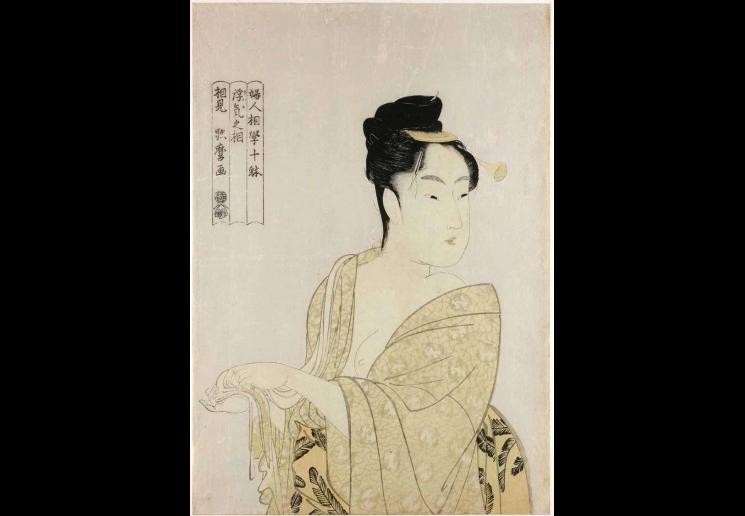IN EARLY MODERN Japan, 1600-1900, thousands of sexually explicit works of art were produced, known as ‘spring pictures’, or shunga. This exhibition, the first in the UK, examines the often tender, funny, beautiful and undoubtedly accomplished shunga that were produced by some of the masters of Japanese art, including Utamaro and Hokusai.
International Loans for the Exhibition
The exhibition is drawn from collections in the UK, Japan, Europe and USA and features about 170 works including paintings, sets of prints and illustrated books with text. Shunga is in some ways a unique phenomenon in pre-modern world culture, in terms of the quantity, the quality and the nature of the art that was produced.
The exhibition explores key questions about what is shunga, how it circulated and to whom, and why was it produced. In particular it begins to establish the social and cultural contexts for sex art in Japan and aims to reaffirm the importance of shunga in Japanese art history.
These works were mostly produced within ukiyo-e (pictures of the floating world), by celebrated artists such as Hishikawa Moronobu (died 1694), Kitagawa Utamaro (died 1806) and Katsushika Hokusai (1760-1849). Earlier, mediaeval narrative art in Japan had already mixed themes of sex and humour.
Shunga Paintings
Luxurious shunga paintings were also produced for ruling class patrons by traditional artists such as members of the Kano school, sometimes influenced by Chinese examples. This was very different from the situation in contemporary Europe, where religious bans and prevailing morality enforced an absolute division between ‘art’ and ‘pornography’.
It is true that official life in this period was governed by strict Confucian laws, but private life was less controlled. Banned after 1722, but rarely suppressed in practice, shunga publications flourished on the boundaries between these two worlds, even critiquing officialdom on occasion. Paintings were never the object of censorship, and national networks of commercial lending-libraries, the main means of distribution for shunga books, were not regulated.
Life in Early Modern Japan
Early modern Japan was certainly not a sex-paradise. Confucian ethics that focused on duty and restraint were promoted in education for all classes, and laws on adultery, were severe. There were also many class and gender inequalities, and a large and exploitative commercial sex industry (as found in Edo’s ‘pleasure quarters’).
However, the values promoted in shunga are generally positive towards sexual pleasure for all participants: in one memorable colour print from the series Erotic Illustrations for the Twelve Months, circa 1788, by Katsukawa Shuncho (worked 1780s-1790s), for instance, a husband and wife enjoy lovemaking at a window in mid-summer, to the cry of a cuckoo.
Women’s sexuality was readily acknowledged and male-male sex recognised in particular social contexts. Although men were the main producers and consumers, it is clear that women also were an important audience; the custom of presenting shunga to women in a marriage trousseau seems to have been common, and some works seem to have been created more for women than for men.
Shunga in the Edo Period
During the late 19th and 20th centuries, shunga was all but removed from popular and scholarly memory in Japan and became taboo. Ironically, it was just at this time that shunga was being discovered and enthusiastically collected by European and US artists such as Lautrec, Beardsley, Sargent and Picasso. The British Museum acquired its first shunga prints as part of the George Witt Collection in 1865 and now has one of the best collections outside of Japan.
Women of the Pleasure Quarters
Also on show, in Room 3, is the screen Women of the Pleasure Quarters by Toyoharu Utamaro (1735-1814), considered one of the most important surviving ukiyo-e paintings from Edo’s ‘floating world’. It depicts courtesans of the Kado-Tamaya (The Jewel House on the Corner) waiting for customers. The six-panel screen shows courtesans amusing themselves by dressing a doll, folding a paper crane, smoking, sleeping and playing the shamisen. Their lavish costumes and hair accessories are typical of the Edo period and date the scene to the Tenmei Era, around 1781-1785.
Among the lacquered accessories depicted at the front of one of the panels of the screen, to the right of the smoking set, is a small box decorated with the emblem of a crane with its wings outstretched. According to Keisei kei (Guide to Courtesans) of 1788, a printed guide to courtesans written by Santo- Kyo-den (1761–1816), this was a crest used by Komurasaki, a high-ranking courtesan in the Tamaya brothel owned by Tamaya Sansaburo.
The name of the house appears, playfully half-hidden, on the entrance curtain towards the centre back on another part of the screen. Kado-Tamaya (‘Tamaya on the corner’) was the first brothel on the left as you turned into Edo-cho-Itcho-me from Naka-no-cho.
The display that accompanies this small side exhibition reveals the culture and sexual economy of the so-called ‘pleasure quarters’ in late 18th-century Japan. The exhibitions are part of ‘Japan 400’, a nationwide UK series of events celebrating 400 years of Japan-British relations.
Shunga: Sex, Pleasures, and Japanese Art, from 3 October 2013 to 5 January 2014, British Museum, Rooms 90-91, Great Russell Street, London WC1B 3DG, www.britishmuseum.org. A catalogue, £50, accompanies the exhibition.

